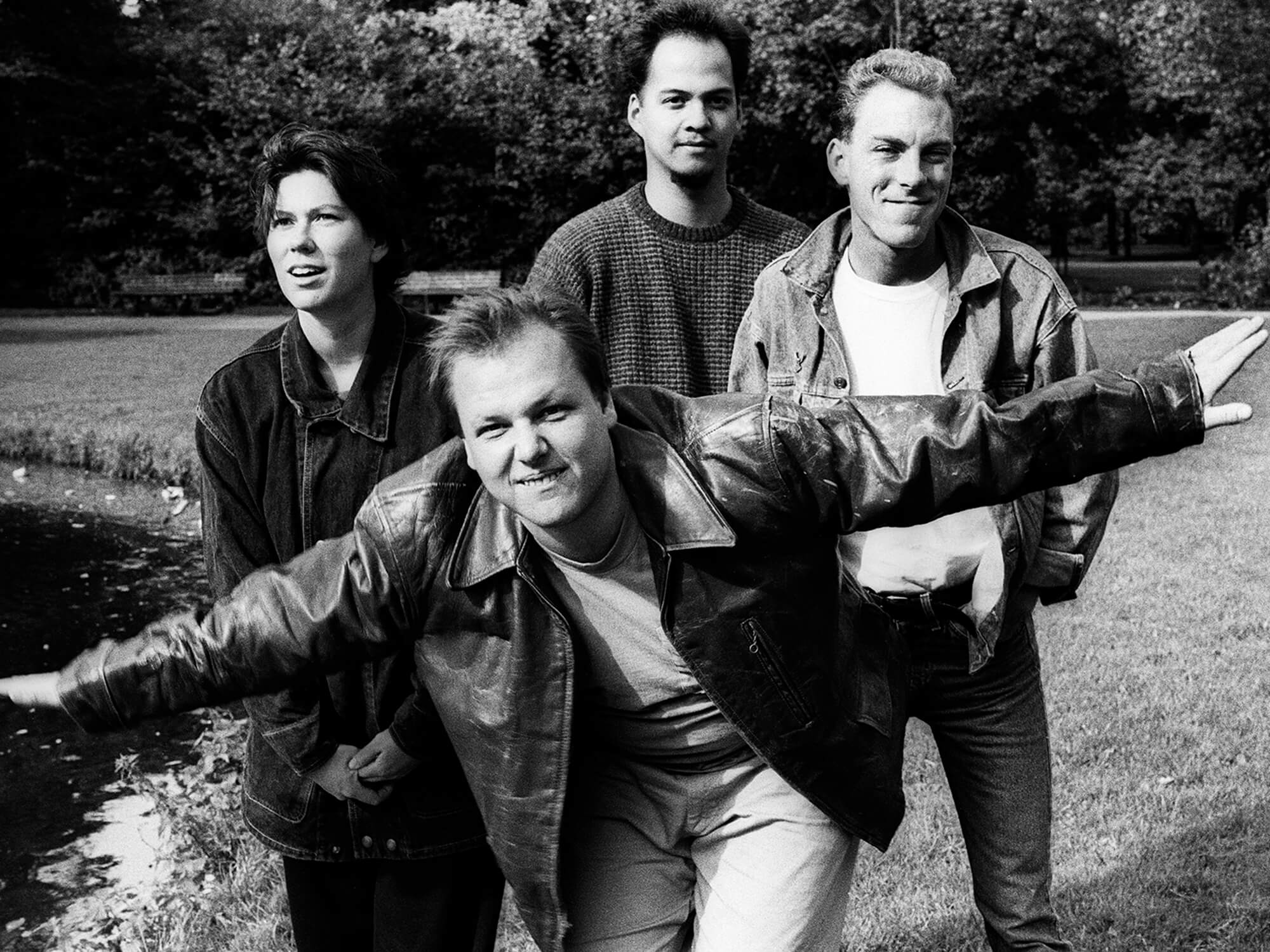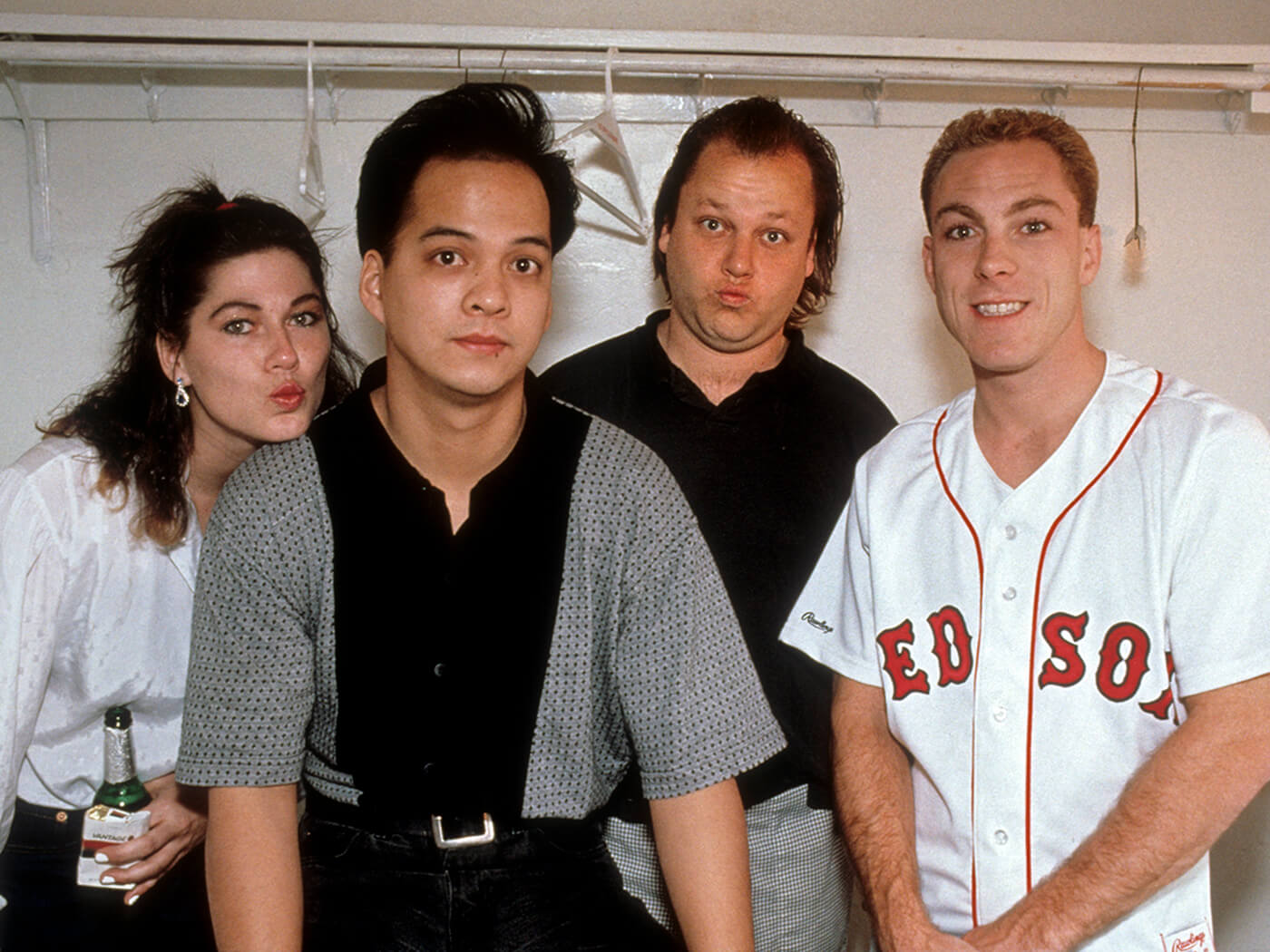Related Tags
Five essential Pixies tracks that guitarists need to hear
They’re one of the most influential bands of their generation, but if you’ve never given Black Francis and co a try, where do you start? Here, you start here…

(L-R) Kim Deal, Black Francis, Joey Santiago and David Lovering of the Pixies, 1988. Image: Rob Verhorst/Redferns via Getty Images
Assembling the perfect band is about circumstance more than it’s about meticulous planning. Here’s a story to illustrate the point: it’s the mid-1980s and you’re a couple of college buddies called Charles Thompson (you go by Black Francis) and Joey Santiago. You have written these really good, really odd pop songs. You want a bassist to join in, so you put an ad in the Boston Phoenix looking for someone who’s “into Hüsker Dü and Peter, Paul and Mary.” “No chops.”
And, because stuff sometimes works out, the only answer you get is from Kim Deal, a songwriting genius who is also perhaps the coolest person to have ever been in a band. Not only that, she knows this guy named David Lovering, a drummer who conveniently happens to be your kind of weirdo. That’s how you build the perfect band. That’s how you build the first iteration of Pixies.
Looking back at almost 40 years of heavy, undeniable influence on everyone from Nirvana to Radiohead, Weezer to PJ Harvey, it’s notable just how quickly it all happened in the moment. Between 1987 and 1991 they put out one EP and four LPs that permanently rewired how people approached the construction of rock music, from the loud/quiet dynamic to the extremes at which noise and melody can coexist. Here, we take a look at five songs to give you a foot in the door with one of the bands.
Start Here: Wave Of Mutilation (Doolittle, 1989)
There aren’t many perfect rock records, but Doolittle is one of them. This pick could have been one of any number of songs (for surrealist hooks see Debaser, for washed inverted Americana see Here Comes Your Man, for bug-eyed euphoric release see Dead etc etc) but Wave of Mutilation says so much about what made Pixies undeniable.
It’s maybe about the weather or returning to the earth or Japanese businessmen killing themselves by driving cars into the ocean, but for every second of its running time it’s a hit. The wailing octaves of the riff proper are as grandiose as anything Brian May ever wrote, but they’re only really played once. That is cool as hell. Bonus: in 2013 a post-Deal Pixies played a ragged version of this song on Jools Holland with the late Muffs frontwoman Kim Shattuck (also on a short list of the coolest people to have ever been in a band) on bass.
Then Go Here: Break My Body (Surfer Rosa, 1988)
There aren’t many perfect rock records, but Surfer Rosa is one of them. It’s not just the songs, which are incredible, but the way it sounds. Recorded with Steve Albini, it feels real in a manner that obviously fed into how indie-rock musicians (and certain massive grunge bands) would present their work over the following decade. It also said that you didn’t have to find a lane. From the grinding, howling mayhem of Bone Machine to the endlessly evocative sweep of Where is My Mind?, it’s like forcing body parts from power-pop and punk and art-rock and surf into a woodchipper and letting the gore wipe you out at the other end.
Break My Body is a mile-marker – it’s got the buzzsaw feel that would be allowed to rip through Doolittle and stars one of the best Francis-Deal co-vocal chorus/bridge combos in the Pixies catalogue, but it’s also a needling oddity. Santiago’s notes are like a bed of nails one moment and cheese wire the next.
Stop Off Here: The Holiday Song (Come On Pilgrim, 1987)
A lot of focus tends to fall on Francis and Deal because of course it does, but this is Santiago’s jam. Launching from a tossed off tangle of desert-bleached acoustic notes, this serves up maybe the most driving, addictive riff in all of his years with Pixies. As a whole Come on Pilgrim is a fascinating thing – an attempt to capture lightning in a bottle that basically worked.
Assembled in a hurry at Fort Apache in Roxbury, the EP’s eight songs were culled from 18 the band recorded (many others would reappear along the years). At this remove, it’s easy to see the rationale behind their selection: from The Holiday Song’s rockist buzz to the wistful Caribou and the almost-jangle of Ed is Dead, they succinctly laid out what they were all about and moved on.
Almost Home: Velouria (Bossanova, 1990)
By this point, things had begun to break apart at the seams. Deal had started the Breeders with her twin sister Kelley – they released their debut Pod in 1990, setting them on the path towards their own post-Pixies classic LP Last Splash in 1993 – while everyone else had moved to Los Angeles to begin work on what would become Bossanova. But, the thing is, this record still rocks.
A stressed out, prickly Pixies still wipe the floor with most other bands. Made with Gil Norton, returning following the breakout success of Doolittle, Bossanova is maybe more inert, a little fussier than earlier works, but in songs like Velouria it’s also more outwardly melodic and straight up pretty. The galloping Allison picks up the baton and runs with it – it’s as lithe and immediate a pop song as you could wish for.
Nightcap: Planet of Sound (Trompe Le Monde, 1991)
The dislocation would soon become a break, but Pixies had one more classic in them before they went off to do all the other stuff they wanted to do. Next to Bossanova this is a cutting and direct guitar record that just wants to riff and riff hard, man. Deal had been sidelined by politicking but Santiago has the time of his life on Planet of Sound, which is part space-age wigout and part greasy garage rocker.
Every available inch of space is filled with screeching bends, metallic chugs and, eventually, a bullish lead line that doesn’t bother waiting for the vocal to step aside, barrelling through without a care for the rubble left behind. It’s eye-opening (and more than a little nuts) to think that this was released the day before Nevermind – despite the way history has conflated their work, imperial phase Pixies had been and gone as a recording band before Nirvana even happened on a wider scale.

Where next?
There aren’t many perfect rock records, but Last Splash is (also) one of them. The Amps’ Pacer, the album Deal made as a side-project in 1995, is also very good, and her 2013 single Are You Mine? is truly one of the most heart-rending songs ever written. There’s a huge seam of gold in the Frank Black (Thompson’s post-Pixies stage alias) catalogue – 1994’s Teenager of the Year just fizzes, from its artwork through Pixies-adjacent songs that are uniformly great.
The reformed Pixies – briefly with Deal as a touring band and without Deal as a recording project – are a harder sell mainly because of the crushing weight of their legacy. Their later albums, made with Paz Lenchantin on bass before her recent exit in a none-more-Pixies fashion, are better than some reviews would have you believe but never likely to hit your turntable ahead of something they made back when they were kids. That’s just the way it is, and they’re not alone in that.
